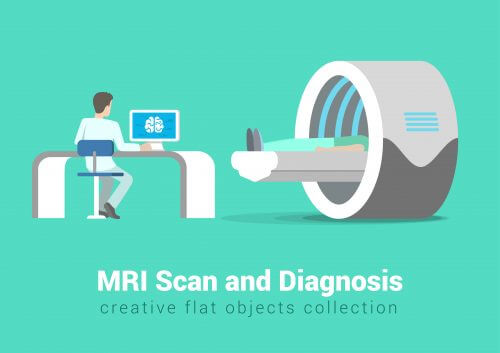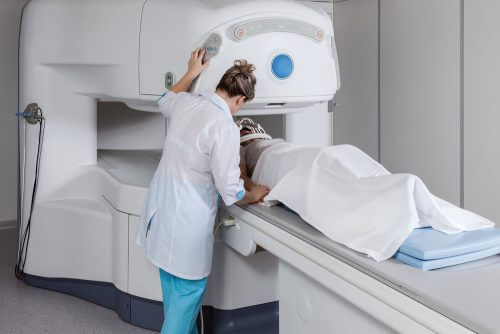- From Ofer Ben Horin's book "MRI The Complete Guide - Medicine and Physics Meet"

The book "MRI The Complete Guide - Medicine and Physics Meet" is the product of a five-year project whose goal is to make the "behind the scenes" of the MRI scanner accessible to the Israeli reader. The book, which is over 300 pages long, presents the physics behind the scanner (which is fundamentally equivalent to the physics of the NMR device and the physics of the fMRI), the variety of tests and its applications, a comprehensive historical overview, an overview of the research currently being carried out in laboratories in Israel and around the world in order to correctly predict the future In the field, safety in MRI, the state of MRI in Israel as of 2016 and many other topics. The book contains examples, illustrations, photos, a complete glossary and an index that are used as a reference tool for anyone interested in getting to know, learning and deepening the field of MRI, thus acquiring a significant advantage in understanding issues related to this developing field.
Ofer Ben Horin, the author of the book, whose writings were also published on the Hidan website, has about 20 years of experience in MRI operation, drug research using MRI and training. He is also engaged in the field of science communication and is known for his ability to simplify and explain complex issues and make them simple to understand. You can read more, see samples of the book at the attached link and purchase it at www.mriguide.co.il. The book was written with the kind help of Prof. Aharon Blank from the Technion, Dr. Dafna Ben-Basht from the Center for Brain Functional Research (fMRI) in Ichilov, Dr. Scott Kleuz, an invasive radiologist from the University of Florida in the United States, and many others.

Here are some pages from the beginning of the main chapter of the book "The Physics Behind the MRI":
The chapter before you focuses on the physical principles on which the operation of the MRI scanner is based, that is, on the theory of magnetic resonance and additions related to MRI such as the gradients and the way to translate the physical data into an image. It is important to remember that for many years the main use of the magnetic resonance phenomenon was the characterization of the structure of various chemical and biological substances and not medical imaging, therefore most of the chapter actually also describes the physics of NMR.
The basis - the spin, the Nakifat, the Nakifat Larmor equation and the Zeeman effect
Before we embark on the fascinating journey into the intricacies of the actual MRI physics, we will present the process of an MRI examination, a process that is basically very simple:
1. Put a person inside a magnet.
2. Transmit a radio wave.
3. Stop the wave transmission.
4. Pick up the signal that the subject's body protons emit, and convert it into an image.
Hence, all that is needed to create magnetic resonance is an external magnetic field, a radio transmitter and a radio receiver.
Now we will expand a little more, and briefly describe the stages of the physical process behind the actions mentioned above:
1. The magnet in the MRI scanner is powerful and relatively homogeneous. The magnet affects the protons in our body and causes them to line up in its direction or in the opposite direction.
2. Transmit a radio pulse at a frequency that causes resonance between it and the protons. This resonance allows energy to pass to the protons, changing their direction.
3. During the return of the protons to their original direction, they emit the energy they received during decay processes, accompanied by the emission of a signal. The strength of the signal depends on the environment, the molecule and the tissue in which they are found.
4. The signal is received with the help of receiving coils and classified to the area from which it came, with the help of gradients and mathematical analysis; This is how the MRI image is created.
In the elemental concepts chapter, we learned about the atom, the basic component of the elements, and saw that it consists of a shell and a nucleus: the shell contains the electrons, while inside the nucleus are the protons and neutrons. The nucleus of a hydrogen atom has a single proton. We also discussed the proton and its spin and spin properties. Now we will repeat the points that are important to us in this context.
• The spin is, simplistically for the sake of explanation, the rotational movement of the proton around itself. It is a vector quantity, meaning it has a direction, and it exists even when there is no external magnetic field.
• When protons are introduced into a magnetic field, two processes occur: the spins of the protons, which until now pointed in random directions, are now all arranged parallel to the magnetic field: in its direction or in the opposite direction. Also, the spin gets a twist: besides rotating on its axis, it also gets a conical circular motion. The spin is, to remind you, a vector, and now it has at the microscopic level (that is, looking at a single proton), a dominant longitudinal component in the direction of the external magnetic field axis, the Z axis, or in the direction opposite to it, and also a transverse component, relatively weak, moving in the XY plane of the axis system .
In the following sections we will focus on each of these processes and delve into them.
Protons in an external magnetic field
When a subject is put into an MRI scanner, the bed moves him into the device, which is actually a giant magnet. The magnet affects, as mentioned, all the spins of the hydrogen protons in our body.
The external magnetic force is marked as B0 and the axis along which this force moves is called the Z axis. The direction of the Z axis is along the length of the subject lying in the scanner: from his feet to his head. Thus the protons in the subject's body, some point towards the legs and some - towards the head.
As written above, when a subject is inserted into an MRI scanner, the external magnetic force causes the spins of the protons to two main phenomena:
1. They stop pointing in random directions and all point towards or against the magnetic field. A phenomenon called the Zeeman effect.
2. They get scolded.
We will explain each of these phenomena in detail.
Zeeman effect
Naturally, the spins of the hydrogen protons point randomly in different directions, but as soon as you place them in a magnetic field, everything changes. If so, when we introduce protons into a magnetic field, they will line up parallel to the magnetic field, and to an equal extent (but not completely equal; we will explain this later), in two directions:
1. In a parallel state, that is, in the same direction as the direction of the external magnetic field.
2. In an antiparallel state, that is, in the opposite direction to the direction of the external magnetic field.
It is easier for protons to manage in a state parallel to the magnetic field, meaning they need less energy to reach this state. This is why it is called a low energy state. On the other hand, protons that line up in a state anti-parallel to the field are in a high energy state, which means they need more energy to reach this state. The protons, for the most part, "don't like to work hard", so the lower energy state is more preferred, and for that reason we find slightly more protons in a state parallel to the magnetic field, than in a state anti-parallel to it.
The phenomenon of splitting the protons into two energy states in the presence of a magnetic field is called the Zeeman effect, while the energy difference between the two states is called the energy difference. The ratio between the two proton populations can be described using the Boltzmann distribution.
There are situations in which certain atomic nuclei can also arrange themselves in more than two states. This is related to their spin value. Atomic nuclei with a spin value of 1/2, such as a hydrogen atomic nucleus, will arrange themselves in two states.
Which protons participate in the magnetic resonance process?
The spins of the protons in the antiparallel state cancel those of the protons in the parallel state, except for the spins of those excess protons. The excess protons, which point in the direction of the magnetic field and whose spin is not canceled by the opposite protons, are called aligned spins. The common magnetic field they create is the field used to create magnetic resonance.
The amount of these protons is seemingly small; When we are at a magnetic force of one tesla, under certain conditions, for every million and seven protons that line up with the direction of the magnetic field, there are one million protons that line up in the opposite direction to the magnetic field. There are therefore only seven excess protons, spins aligned, for the production of the magnetic resonance signal. However, since these are very many millions of protons, the amount of excess protons is not small at all.
If we still want to further increase the number of excess protons, it can be done in two ways:
1. Lowering the temperature.
2. Increasing the strength of the external magnetic field.
The more we lower the temperature and increase the strength of the external magnetic field, the more excess protons will be added to us. However, even if we continue to work at room temperature and with a low magnetic intensity, we will still have a lot of excess protons, which we can later use in the signal they will emit. It should be noted that under such conditions, the transition energy will be low and the magnetic resonance effect, i.e. the emitted signal, will be too weak; Therefore strong magnets are required.
You can read more free samples about MRI physics, the scanner's tests and applications, the past, the present and the future in the field, in the book "MRI the Complete Guide - Medicine and Physics Meet" on the guide website, from where it can also be purchased.

6 תגובות
well written
Thanks.
If anyone is interested in what can be done with an MRI, go to the link of my name. This device has many amazing capabilities, and also knows how to dismantle doors..
Yaron, the book also has a taste and more so in the context of the mathematical algorithm that enables the reception of the image and also about the way the gradient coils work, which produce controlled changes in the magnetic field for spatial coding of the signal. Only three-four pages were brought here from a chapter that is over 100 pages long.
MRI is not just physics, the subject is taught in a university course in electrical engineering. No offense here, just an update. This is at least a 50% optimization in parameter estimation as a way to extract parameters when the information is missing. This topic is very advanced mathematically. Therefore, the book is comprehensive on the subject of physics and medicine, but lacks a description at least in the taste of the mathematical algorithm, which in my estimation is half way there. Without the algorithm it is not possible to receive images.
Well done, it is important that there is finally a book in Hebrew about the matter, I remember as a student how I looked for material in the library about the matter and everything was in complicated physical English